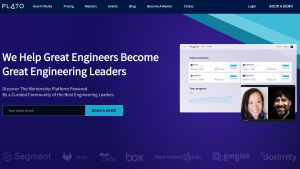
What is ‘No Code (technology)’?
Software without code – It’s unfathomable.
Code is the foundation of various applications and software. It serves as a set of instructions that a computer, server, or another system can follow to perform its task. To write these instructions, one must know how to code.
But what if you could write a program without writing a single line of code?
This is the premise of code-free development, a new-age software development method. Using a wireless platform, it is possible to develop a program without writing the underlying code.
Development without code can be regarded as a type of visual programming. Instead of using a text-based environment, users can manage the elements through a drag-and-drop interface. For instance, the MIT Media Lab’s scratch programming language is known for its use of graphics programming blocks to teach encoding to individuals.
To most people without coding knowledge, the idea of creating a web application or simply a website may seem impossible and incomprehensible. A space that was once available only to developers and those who know how to code is now open to everyone. It doesn’t matter if you’re a programmer or not.
This technology refers to the use of software tools that allow people to build and deploy applications and websites without requiring any knowledge of programming languages. With no-code tools, users can create custom software applications, websites, and other digital products using visual interfaces, drag-and-drop functionality, and pre-built components.
This technology empowers people without coding skills to create digital products that they would otherwise have to outsource to developers. This can save time, reduce costs, and increase the speed of product development.
Additionally, no-code technology has the potential to democratize software development, allowing a wider range of people to participate in the creation of digital products and services.
No Code Vs Low Code
These are both software development approaches that aim to simplify the process of building software applications. However, there are some key differences between the two.
This technology allows users to build and deploy applications without needing any knowledge of programming languages. Users can create applications using visual interfaces, drag-and-drop functionality, and pre-built components, allowing them to focus on the overall functionality and design of the application, rather than on the underlying code.
No-code platforms are typically designed for non-technical users, such as business analysts or marketers, who need to create simple applications quickly.
Low-code technology, on the other hand, is designed to give developers a faster and more efficient way to build applications. Low-code platforms provide pre-built components and templates that developers can use to speed up the development process but still require some coding knowledge to create custom functionality. Low-code platforms are typically used by professional developers who need to build more complex applications.
In general, these platforms are simpler to use and require less technical knowledge, while low-code platforms provide more flexibility and customization options for professional developers. However, there is often some overlap between the two approaches, and some platforms may offer both no and low code functionality depending on the user’s needs.
Best No Code Platforms Out There
No-code technology has gained popularity among companies of all sizes, from small startups to large enterprises. Some examples of companies that use such platforms to build applications include:
Shopify –
An e-commerce platform that allows merchants to build online stores without needing to write any code.
a website builder that provides a drag-and-drop interface for creating custom websites without any coding knowledge.
Zapier –
a platform that allows users to automate workflows between different apps without writing any code.
Airtable –
a database management tool that provides a visual interface for building custom databases and workflows.
Unqork –
a platform for building enterprise-grade applications, including complex financial and insurance applications.
Bubble –
a platform for building web and mobile applications without coding, with a focus on building complex applications.
Webflow –
a platform for building custom websites and web applications using a visual interface, with advanced functionality for designers.
These are just a few examples of the many companies that use no-code technology to build applications quickly and efficiently, without the need for a team of developers.
Companies built using no-code platforms
This technology wouldn’t be so famous if it didn’t work. These days there are companies built with no code platforms, let’s take a look at some of them.
Bloom Institute of Technology

Bloom raised $ 4 million and redefines virtual education based on a unique Income Share Agreement (ISA) model. This model allows students to pay for most of their tuition in the future after landing a job. With a combination of tools such as Typeform, Airtable, and Retool, Boom launched its own MVP program for over 3,000 students. They have added other tools such as Webflow, Salesforce, Calendly, and Zapier to help the platform grow and expand.
Comet

Comet is a one-stop shop for technology and data freelancers looking to find work. Comet also allows companies to reach out to talent for their projects.
Comet was created with the help of a platform called Bubble.io, The average MRR (Monthly Recurring Revenue) at Comet is over $ 800,000. Comet has helped over 1000 companies acquire talent. It is not known how much of the current solution runs on the platform, but it is still used for critical parts of the application. In any case, Comet is a clear example of the fact that no coding is required to build a successful digital media business.
Qoins

Qoins is built on Bubble.io as well. Bubble is an excellent platform for founders to turn their ideas into working solutions. Qoins is a fintech company that helps individuals pay off debt from student loans to credit card loans.
When the startup took off, Qoins continued to use Bubble for much of the business as it helped them get things that would normally require a team of developers. Even today, the company is largely based on Bubble, although some aspects have been renewed with the traditional code.
Plato

Plato connects engineers with mentors from some of the best companies in the world. Plato runs its entire back office and built its tracking system and event-specific landing pages on Bubble’s no and low code platform.
UX Designers Watch out!
No code technology can have a significant impact on UX (user experience) designers. With no-code platforms, it becomes easier for non-technical individuals to create websites and digital products, which means UX designers may work more closely with non-designers in the product development process.
This technology can also provide UX designers with new opportunities to create custom user experiences that may not have been possible before.
For example, no-code platforms may allow UX designers to quickly prototype and test different user interface designs, gather feedback, and make changes without needing to rely on developers to implement those changes.
On the other hand, no-code technology may also present challenges for UX designers. For example, some platforms may have limitations in terms of design flexibility, which could restrict a designer’s creativity. Additionally, these platforms may not be suitable for complex projects that require custom coding and integrations, which may limit the scope of a designer’s work.
However, as no-code technology continues to evolve, it may become an increasingly important part of the UX designer’s toolkit.
What does it take to build with No Code?
To build an application on a no-code technology platform, you generally need the following infrastructure:
A computer or device with an internet connection: Most such platforms are cloud-based, meaning that the application development environment and data storage are located in the cloud. You will need a computer or device with an internet connection to access the platform.
A web browser: You will need a web browser to access the no-code platform’s user interface and design the application.
Data storage: Most platforms provide data storage as part of their service, but you may need to purchase additional storage if you are building a large application.
APIs and integrations: Many no-code platforms offer pre-built integrations with popular software applications and APIs, which can be used to build more complex applications. If you need to integrate with a custom API or software application, you may need to configure the integration manually.
Security: As with any application, security is an important consideration when building an application on such a platform. You will need to ensure that the platform provides adequate security measures to protect your application and data from unauthorized access.
Overall, the infrastructure requirements for building an application on a no-code platform are relatively minimal compared to traditional software development. These platforms aim to simplify the application development process by providing a user-friendly interface that allows non-technical users to build applications quickly and efficiently.
What’s in store for the future of No Code
In the words of Chris Wanstrath, CEO, of GitHub – ‘The future of coding is no coding at all’.
No-code technology has been gaining significant traction in recent years, and as a result, the amount of investment in the space has been increasing steadily. According to a report by Gartner, the no-code/low-code market is expected to grow from $13.2 billion in 2020 to $23.3 billion in 2022.
The future of this technology looks promising, as it has already started to transform the way applications are built and delivered. Here are some potential trends for the future of no-code:
Increased adoption: As the technology becomes more accessible and user-friendly, we can expect to see a continued increase in adoption across a wide range of industries and use cases.
Collaboration between technical and non-technical teams: No-code technology allows non-technical users to create applications with ease, while still enabling collaboration with technical teams. This collaboration will likely become more seamless in the future as no-code platforms continue to evolve.
Greater customization and complexity: As these platforms become more advanced, we can expect to see greater customization and complexity in the applications that can be built. This will enable users to create more sophisticated applications without the need for extensive coding knowledge.
Integration with AI and automation: No-code platforms are well-suited for integration with artificial intelligence and automation technologies. As these technologies become more prevalent, we can expect to see more sophisticated no-code platforms that can leverage AI and automation to create even more powerful applications.
Continued investment and growth: With significant investment being made in the no-code space, we can expect to see continued growth and innovation in the coming years. New platforms will emerge, and existing platforms will continue to evolve and improve.
The future of this technology looks bright, with the potential to transform the way applications are built and delivered, making it more accessible and efficient for businesses of all sizes.




